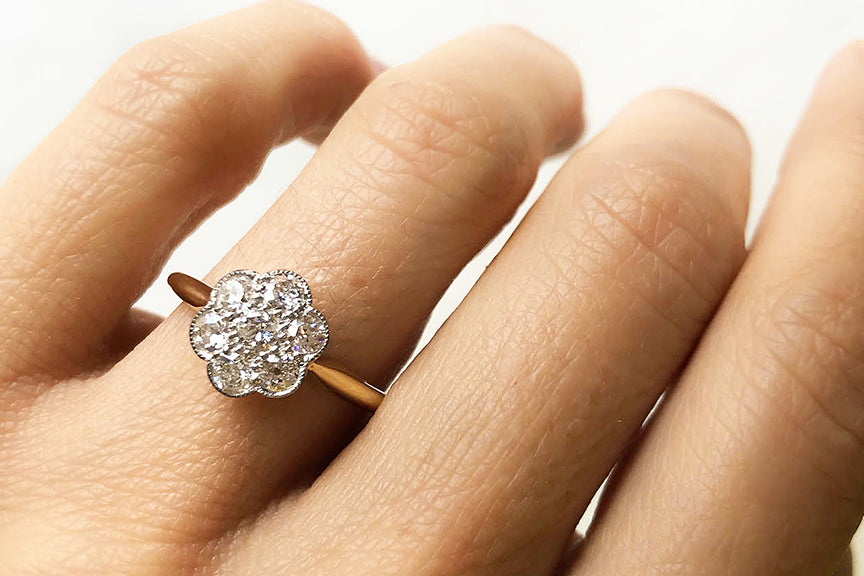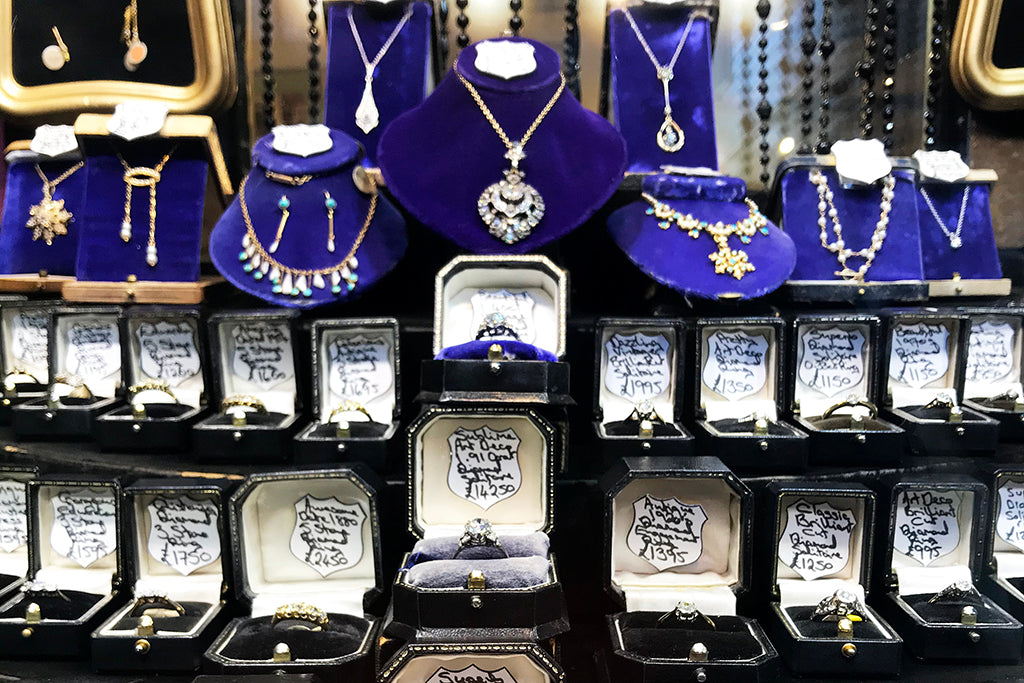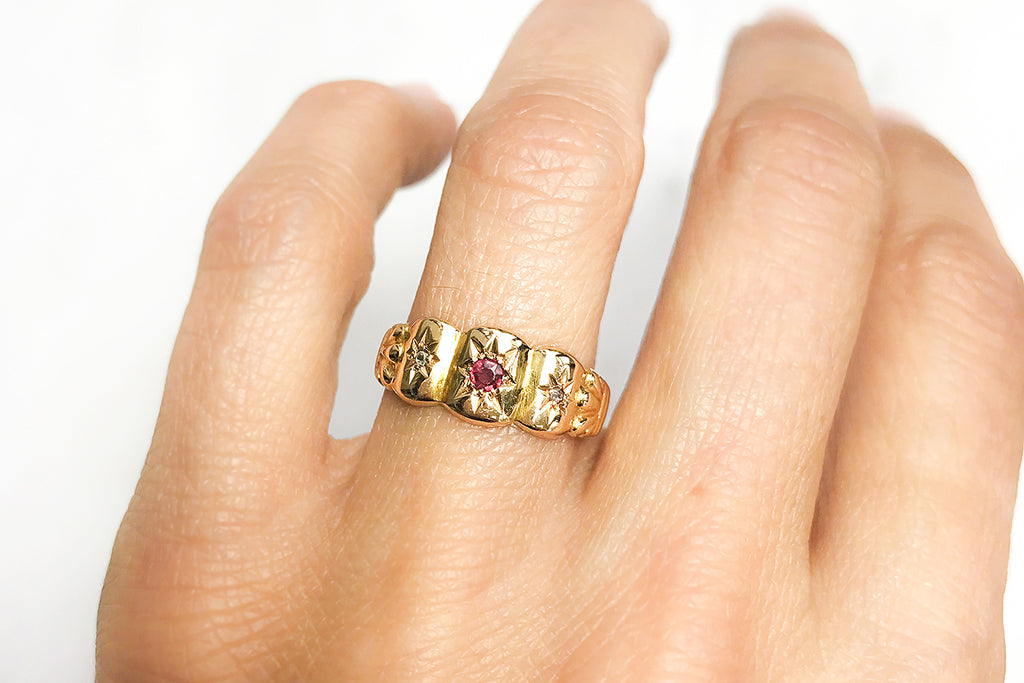
Edwardian Daisy Cluster Rings: Antique Elegance for the Modern Romantic
Delicate, romantic, and steeped in history, Edwardian daisy cluster rings remain one of the most sought-after antique engagement ring styles today. Discover their symbolic beauty, signature craftsmanship, and enduring appeal in our ultimate guide to Edwardian daisy rings.
The Enduring Charm of Edwardian Daisy Rings
There’s a timeless magic to Edwardian daisy cluster rings - an effortless blend of delicate craftsmanship, sentimental symbolism, and luminous beauty. Popular at the turn of the twentieth century, these exquisite designs have captivated jewellery lovers for over a century, and today, they are more coveted than ever.
But what exactly is an Edwardian daisy cluster ring? In simple terms, it’s a style of antique ring where a central diamond or gemstone is surrounded by a circle of smaller stones, creating a floral "daisy" effect. Edwardian daisy rings typically feature intricate metalwork, old-cut or rose-cut diamonds, and the unmistakable romance of the Belle Époque era.
With growing interest in vintage and antique engagement rings among modern buyers, Edwardian daisy cluster rings offer a unique opportunity to wear a piece of history - one imbued with artistry, authenticity, and enduring love.
What Defines an Edwardian Daisy Cluster Ring?

Edwardian jewellery, created between 1901 and 1910 during the reign of King Edward VII, is known for its ethereal lightness and extraordinary craftsmanship. This era embraced the influence of Art Nouveau and saw the rise of platinum as a favoured metal for fine jewellery, allowing for more delicate and detailed designs than ever before.
Key characteristics of Edwardian daisy cluster rings include:
- Precious Metals: The strength and lightness of platinum allowed jewellers to create incredibly intricate designs, with fine filigree and milgrain work highlighting the dazzling diamonds. These rings often feel lighter, brighter, and airier - true to the Edwardian spirit of refined elegance. That said, a diamond daisy ring in yellow gold offers a different kind of beauty - warm, rich, and timeless. Some Edwardian pieces combine platinum-topped gold designs, pairing the strength of platinum for stone settings with the glow of gold for the band.
- Old Cut or Rose-Cut Diamonds: These hand-cut stones shimmer with a softer, more romantic sparkle than modern diamonds.
- Daisy Formation: A central diamond or gemstone encircled by smaller stones in a symmetrical, petal-like arrangement.
- Milgrain Detailing: Tiny beaded edges along the metalwork, adding a soft, lace-like texture.
An authentic Edwardian diamond daisy cluster ring reflects the era’s obsession with nature, artistry, and understated luxury. When you see a genuine vintage Edwardian daisy ring, you’re looking at a piece of craftsmanship made to last generations.
The Romantic Symbolism of Daisy Engagement Rings
 Throughout history, flowers have carried rich symbolism, and the daisy is no exception. Representing purity, innocence, loyalty, and new beginnings, daisies made perfect symbols for love and commitment - a message beautifully captured in jewellery.
Throughout history, flowers have carried rich symbolism, and the daisy is no exception. Representing purity, innocence, loyalty, and new beginnings, daisies made perfect symbols for love and commitment - a message beautifully captured in jewellery.
During the Victorian and Edwardian eras, floral motifs in jewellery flourished. Lovers exchanged rings and brooches adorned with flowers, weaving personal me
aning into their gifts. In an Edwardian daisy engagement ring, these timeless sentiments are preserved, making them an especially romantic choice for those seeking an engagement ring steeped in symbolism.
Choosing an antique daisy ring is not just about beauty; it’s about carrying forward a message of hope, renewal, and everlasting love.
Why Choose an Edwardian Daisy Engagement Ring Today?

Some of the many reasons to fall in love with an Edwardian daisy ring include:
- Unparalleled Craftsmanship: Each Edwardian ring was handcrafted, meaning no two are exactly alike - a beautiful contrast to mass-produced modern jewellery.
- Sustainability: Buying an antique Edwardian engagement ring is an eco-friendly choice, celebrating existing craftsmanship without contributing to new mining or manufacturing.
- Romantic History: Wearing an Edwardian diamond engagement ring connects you to a bygone era of romance, refinement, and enduring elegance.
- Investment Value: Fine antique jewellery often retains or appreciates in value, making it a meaningful and potentially wise investment.
With their blend of beauty, sentiment, and sustainability, Edwardian diamond daisy cluster rings remain one of the most enchanting engagement ring choices today.
Buying Tips: How to Find the Perfect Edwardian Daisy Ring

Finding your perfect Edwardian daisy cluster ring is a journey worth taking with care and knowledge.
Here’s what to look for:
- Authenticity: Examine the setting and craftsmanship. True Edwardian rings often feature platinum or platinum-topped gold and intricate detailing.
- Diamond Cuts: Look for old-cut or rose-cut diamonds, with their softer sparkle and slightly irregular shapes, a hallmark of antique craftsmanship.
- Hallmarks and Stamps: Although not always present, authentic period pieces may bear hallmarks indicating metal content or makers' marks.
- Trusted Dealers: Work with reputable antique jewellers who can provide provenance and expertise, ensuring you’re investing in a genuine piece.
When browsing Edwardian rings for sale or Edwardian engagement rings for sale, it's wise to ask questions, request certificates where available, and choose sellers who specialise in antique jewellery.
We at The Vintage Ring Co. provide a unique certificate of authenticity, compiled and signed by a third party valuer at The Goldsmith Company's Assay Office in London. Learn more about our certificates.
Edwardian Daisy Cluster Rings for Sale: Where to Begin
If you’re enchanted by the delicate beauty of Edwardian rings, we invite you to explore our curated collection. Whether you’re searching for a vintage Edwardian daisy ring, a diamond daisy ring in yellow gold, or a classic platinum design, our collection celebrates the artistry and romance of this special era.
FAQS
"What is an Edwardian daisy cluster ring?"
In simple terms, it’s a style of antique ring where a central diamond or gemstone is surrounded by a circle of smaller stones, creating a floral "daisy" effect. They're typically created in precious metal, set with old-cut or rose-cut diamonds, and feature intricate metalwork like milgrain beading.
"How do you know if a ring is Edwardian?"
True Edwardian rings often feature old-cut or rose-cut diamonds with softer sparkle and slightly irregular shapes, and hallmarks or makers' marks that can be professionally assessed to verify age.
"What does a daisy ring symbolise?"
Representing purity, innocence, loyalty, and new beginnings, daisies make perfect symbols for love and commitment.



